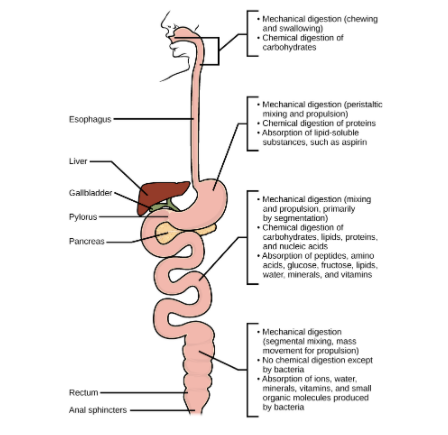
What is peristalsis? How does it help in digestion?
Answer
585.3k+ views
Hint:It usually occurs in oesophagus also known as food pipe. It helps to push food forward.
Peristalsis is a series of wave-like contractions of the muscles that are involved in the food movement and in the movement of other liquid particles in the digestive tract to various processing organs that are located in the digestive.

Complete answer:
Involuntary movements of the longitudinal and circular muscles, primarily in the digestive tract but occasionally in other hollow tubes of the body, that occur in progressive wavelike contractions. Peristaltic waves occur in the oesophagus, stomach, and intestines.
Smooth muscles contract behind the bolus to prevent it from being squeezed back into the mouth. Then rhythmic, unidirectional waves of contractions work to rapidly force the food into the stomach. The migrating motor complex (MMC) helps trigger peristaltic waves.
It helps in pushing food forward by rhythmically contracting oesophagus.
The strong wave-like motions of the smooth muscle in the oesophagus carry the food to the stomach, where it is churned into a liquid mixture called chyme. So, digestion becomes easy as food is converted into simpler form due to peristalsis the food gets broken down into simpler forms.
When chyme passes from the stomach into the small intestine, peristaltic waves shift it back and forth and mix it with digestive enzymes and fluids.
Note: Food like almond and almond milk can increase peristalsis for good digestion. So, people should take these kinds of food so that food can be better digested.
Peristalsis is a series of wave-like contractions of the muscles that are involved in the food movement and in the movement of other liquid particles in the digestive tract to various processing organs that are located in the digestive.

Complete answer:
Involuntary movements of the longitudinal and circular muscles, primarily in the digestive tract but occasionally in other hollow tubes of the body, that occur in progressive wavelike contractions. Peristaltic waves occur in the oesophagus, stomach, and intestines.
Smooth muscles contract behind the bolus to prevent it from being squeezed back into the mouth. Then rhythmic, unidirectional waves of contractions work to rapidly force the food into the stomach. The migrating motor complex (MMC) helps trigger peristaltic waves.
It helps in pushing food forward by rhythmically contracting oesophagus.
The strong wave-like motions of the smooth muscle in the oesophagus carry the food to the stomach, where it is churned into a liquid mixture called chyme. So, digestion becomes easy as food is converted into simpler form due to peristalsis the food gets broken down into simpler forms.
When chyme passes from the stomach into the small intestine, peristaltic waves shift it back and forth and mix it with digestive enzymes and fluids.
Note: Food like almond and almond milk can increase peristalsis for good digestion. So, people should take these kinds of food so that food can be better digested.
Recently Updated Pages
The number of solutions in x in 02pi for which sqrt class 12 maths CBSE

Write any two methods of preparation of phenol Give class 12 chemistry CBSE

Differentiate between action potential and resting class 12 biology CBSE

Two plane mirrors arranged at right angles to each class 12 physics CBSE

Which of the following molecules is are chiral A I class 12 chemistry CBSE

Name different types of neurons and give one function class 12 biology CBSE

Trending doubts
One Metric ton is equal to kg A 10000 B 1000 C 100 class 11 physics CBSE

What is 1s 2s 2p 3s 3p class 11 chemistry CBSE

Discuss the various forms of bacteria class 11 biology CBSE

State the laws of reflection of light

Explain zero factorial class 11 maths CBSE

An example of chemosynthetic bacteria is A E coli B class 11 biology CBSE




